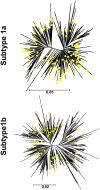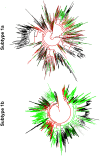The global spread of hepatitis C virus 1a and 1b: a phylodynamic and phylogeographic analysis
- PMID: 20041120
- PMCID: PMC2795363
- DOI: 10.1371/journal.pmed.1000198
The global spread of hepatitis C virus 1a and 1b: a phylodynamic and phylogeographic analysis
Abstract
Background: Hepatitis C virus (HCV) is estimated to affect 130-180 million people worldwide. Although its origin is unknown, patterns of viral diversity suggest that HCV genotype 1 probably originated from West Africa. Previous attempts to estimate the spatiotemporal parameters of the virus, both globally and regionally, have suggested that epidemic HCV transmission began in 1900 and grew steadily until the late 1980s. However, epidemiological data suggest that the expansion of HCV may have occurred after the Second World War. The aim of our study was to elucidate the timescale and route of the global spread of HCV.
Methods and findings: We show that the rarely sequenced HCV region (E2P7NS2) is more informative for molecular epidemiology studies than the more commonly used NS5B region. We applied phylodynamic methods to a substantial set of new E2P7NS2 and NS5B sequences, together with all available global HCV sequences with information in both of these genomic regions, in order to estimate the timescale and nature of the global expansion of the most prevalent HCV subtypes, 1a and 1b. We showed that transmission of subtypes 1a and 1b "exploded" between 1940 and 1980, with the spread of 1b preceding that of 1a by at least 16 y (95% confidence interval 15-17). Phylogeographic analysis of all available NS5B sequences suggests that HCV subtypes 1a and 1b disseminated from the developed world to the developing countries.
Conclusions: The evolutionary rate of HCV appears faster than previously suggested. The global spread of HCV coincided with the widespread use of transfused blood and blood products and with the expansion of intravenous drug use but slowed prior to the wide implementation of anti-HCV screening. Differences in the transmission routes associated with subtypes 1a and 1b provide an explanation of the relatively earlier expansion of 1b. Our data show that the most plausible route of the HCV dispersal was from developed countries to the developing world. Please see later in the article for the Editors' Summary.
Conflict of interest statement
The authors have declared that no competing interests exist.
Figures




Similar articles
-
Global Origin and Spatiotemporal Spread of Hepatitis C Virus Epidemic Genotypes/Subtypes: A Complete Genome-Based Phylodynamic and Phylogeographic Analyses.J Med Virol. 2024 Dec;96(12):e70123. doi: 10.1002/jmv.70123. J Med Virol. 2024. PMID: 39697008
-
Epidemic history of major genotypes of hepatitis C virus in Uruguay.Infect Genet Evol. 2015 Jun;32:231-8. doi: 10.1016/j.meegid.2015.03.021. Epub 2015 Mar 20. Infect Genet Evol. 2015. PMID: 25801607
-
Phylogenetic analysis of the emergence of main hepatitis C virus subtypes in São Paulo, Brazil.Braz J Infect Dis. 2015 Sep-Oct;19(5):473-8. doi: 10.1016/j.bjid.2015.06.010. Epub 2015 Aug 19. Braz J Infect Dis. 2015. PMID: 26296325 Free PMC article.
-
Investigation of the pattern of diversity of hepatitis C virus in relation to times of transmission.J Viral Hepat. 1997;4 Suppl 1:69-74. doi: 10.1111/j.1365-2893.1997.tb00163.x. J Viral Hepat. 1997. PMID: 9097281 Review.
-
Global epidemiology of hepatitis C virus infection: An up-date of the distribution and circulation of hepatitis C virus genotypes.World J Gastroenterol. 2016 Sep 14;22(34):7824-40. doi: 10.3748/wjg.v22.i34.7824. World J Gastroenterol. 2016. PMID: 27678366 Free PMC article. Review.
Cited by
-
Historical Trends in the Hepatitis C Virus Epidemics in North America and Australia.J Infect Dis. 2016 Nov 1;214(9):1383-1389. doi: 10.1093/infdis/jiw389. Epub 2016 Aug 28. J Infect Dis. 2016. PMID: 27571901 Free PMC article.
-
Global Transmission Dynamics of Measles in the Measles Elimination Era.Viruses. 2017 Apr 16;9(4):82. doi: 10.3390/v9040082. Viruses. 2017. PMID: 28420160 Free PMC article.
-
Characterization of a canine homolog of hepatitis C virus.Proc Natl Acad Sci U S A. 2011 Jul 12;108(28):11608-13. doi: 10.1073/pnas.1101794108. Epub 2011 May 24. Proc Natl Acad Sci U S A. 2011. PMID: 21610165 Free PMC article.
-
Correlates of hepatitis C viral clustering among people who inject drugs in Baltimore.Infect Genet Evol. 2020 Jan;77:104078. doi: 10.1016/j.meegid.2019.104078. Epub 2019 Oct 24. Infect Genet Evol. 2020. PMID: 31669367 Free PMC article.
-
Using host genetics to infer the global spread and evolutionary history of HCV subtype 3a.Virus Evol. 2021 Jul 9;7(2):veab065. doi: 10.1093/ve/veab065. eCollection 2021. Virus Evol. 2021. PMID: 34532064 Free PMC article.
References
-
- Shepard CW, Finelli L, Alter MJ. Global epidemiology of hepatitis C virus infection. Lancet Infect Dis. 2005;5:558–567. - PubMed
-
- Simmonds P, Bukh J, Combet C, Deleage G, Enomoto N, et al. Consensus proposals for a unified system of nomenclature of hepatitis C virus genotypes. Hepatology. 2005;42:962–973. - PubMed
-
- Simmonds P. Genetic diversity and evolution of hepatitis C virus–15 years on. J Gen Virol. 2004;85:3173–3188. - PubMed
-
- Simmonds P. The origin and evolution of hepatitis viruses in humans. J Gen Virol. 2001;82:693–712. - PubMed
-
- Choo QL, Kuo G, Weiner AJ, Overby LR, Bradley DW, et al. Isolation of a cDNA clone derived from a blood-borne non-A, non-B viral hepatitis genome. Science. 1989;244:359–362. - PubMed
Publication types
MeSH terms
Substances
LinkOut - more resources
Full Text Sources
Other Literature Sources
Medical

